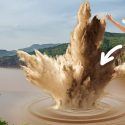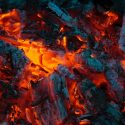What was that shaking you felt? Was it an earthquake? As you rush out of your house, you see a giant mass of mud heading your way, and it’s swallowing trees, cars, and everything in its path. It even took an entire house away. What could it do to you?
Mudslides occur at the bottom of slopes or canyons. Heavy rainfall, and natural disasters like floods and hurricanes that cause surges in water, can increase the chances of a mudslide. As water rapidly accumulates in the ground, it saturates the rock, dirt and debris. This makes the slope unstable. So the mud flows down, covering and destroying everything in its path.
In the U.S., mudslides cause $3.5 billion in damage and kill up to 50 people each year. And worldwide, between 1998 and 2017, landslides and mudslides affected almost 5 million people and killed more than 18,000. Could you outrun a mudslide? What are the warning signs that one is developing? And how could a bathtub save your life?
Step 1. Don’t run downhill
Mudslides can devastate roads and even entire communities located near a slope. If you’re in the path of a mudslide, you must escape. But don’t try to run downhill. You can’t outrun a mudslide as the rock, dirt and debris they carry can travel up to 56 km/h (35 mph). Instead, go to the side of where the mudslide is flowing to avoid getting caught in its drift.
Step 2. Get in a bathtub
Finding shelter should be your last resort as mudslides can swipe entire houses with them or even bury them. But if you can’t escape the mudslide, you’ll need a good shelter at home. Unlike what you might do in other natural disasters, don’t hide in the basement. Instead, get in the bathtub, as it will protect you from the mud that can solidify very quickly once the water escapes.
Step 3. Save the forests
Deforestation can remove protective natural drainage systems and make the soil prone to collapsing. As more people moved to Sugar Loaf Mountain in Freetown, Sierra Leone, they uprooted many trees to build houses. In 2017, a heavy rainfall that flooded the town caused a massive mudslide and killed more than 1,100 people. Building adequate drainage systems for slopes and building houses in safe locations are the best ways to prevent mudslides from killing people.
Step 4. Look for signs
Unlike natural disasters that are predictable, mudslides are typically unexpected. And there aren’t many warning signs other than heavy rainfall. If you see a sudden rise in the local water level, that could be an indicator of debris flow upstream during rain, immediately evacuate the area and alert the authorities. A trickle of mud flowing down can also be a sign of a developing mudslide. You can also look for tilted trees, power line poles or walls indicating a shift in the land.
Step 5. Look to the Past
In 2014, in Oso, U.S., 21.3 m (70 ft) of mud on a slope swallowed a nearby river, 1.6 km (1 mi) of a state highway and parts of the town. A hillside collapsed, sweeping over the town in a massive mud flow that injured 10 people and killed 43. Scientists believe that previous mudslides and slope erosion during the 1930s contributed to this enormous mudslide. And since then, numerous mudslides have occurred due to heavy seasonal rainfall. It’s important to know if mudslides have occurred in your area so you can develop an evacuation plan.
You survived a mudslide, but the rainfall hasn’t stopped, and it looks like that river is about to overflow. Could you survive a flood?
Sources
- “What Causes Mudslides?“. 2020. Wonderopolis.Org.
- “Landslides And Mudslides|CDC“. 2022. Cdc.Gov.
- “What Is A Landslide And What Causes One? | U.S. Geological Survey“. 2022. Usgs.Gov.
- “11 Facts About Landslides”. 2022. Dosomething.Org.
- “Death Toll From Landslides Vastly Underestimated – Nature“. 2012. Nature.

















